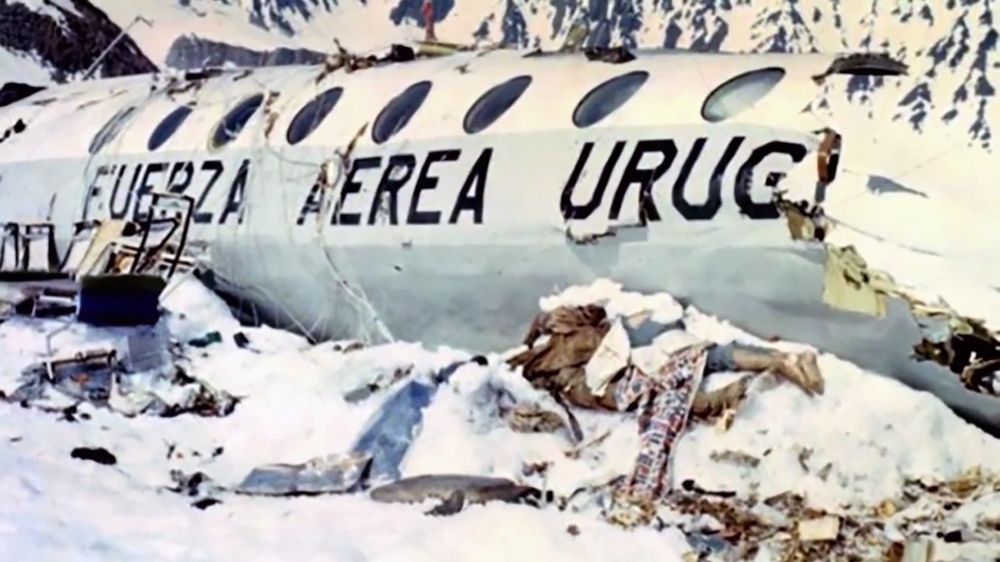A Uruguayan Air Force Flight 571, carrying 45 passengers, crashed into the Andes on October 13, 1972. Authorities in Uruguay, Chile and Argentina launched and supported extensive search and rescue operations. Still, after ten days without any results, the passengers were presumed dead, and the search was discontinued. After 70 days, two bearded and emaciated boys appeared in Chile, coming on foot out of the Andes and claiming to be the missing plane’s passengers. Rescuers watched in disbelief as the boys led them to 14 other survivors from the plane who had lived for over two months on the mountain. As soon as they were rescued, international media attention was focused on how they had outlived such a hostile environment for so long.
Most of the 45 people on board were in their late teens and early twenties, members of an Uruguayan rugby team travelling to Chile for an exhibition, and they went wild when the plane hit turbulence and dropped several hundred feet. As the plane hit a second air pocket and dropped, some more-the passengers suddenly spotted a mountain face just 10 to 20 feet away from them as they fell beneath the cloud cover. The plane was chartered to fly the Old Christians Rugby Club of Montevideo, Uruguay, to Santiago. A total of 19 members were aboard, while most of the other passengers were friends and family of team members. As the co-pilot flew through the cloud-obscured mountains, he began his descent prematurely. Survivors reported feeling turbulence before a black ridge appeared directly in front of the plane. Despite the pilot’s attempts to fly straight up and over the ridge, the plane hit the mountain, breaking into several pieces and skidding until it came to rest on a glacier. In addition to the pilot and the co-pilot who operated the controls, 12 other people died in the crash. The survivors learned of the cancellation of the search via a makeshift radio on their eleventh day in the mountains. The survivors quickly ran out of food.
Survivor Roberto Canessa recalls
After just a few days, we were feeling the sensation of our bodies consuming themselves to survive. Eventually, after prayer and heartbreaking deliberation, all but one of them agreed that the solution was to eat the dead. If they hadn’t resorted to cannibalism, all those remaining would have perished.
Search and rescue
The survivors were taking shelter in the plane’s fuselage when an avalanche struck, killing eight more and nearly burying the rest. To find help, four expedition members set out in search of the local valley on November 15. They found food and medicine in the tail of the wrecked plane, even though they were forced to turn back. The survivors realized that climbing the mountain to the West would be the only way to reach help, so they knit insulation from the aeroplane into a sleeping bag so that the men they would take on a second expedition could keep warm. The climbers reached the summit on the third day of their three-day journey and realized that they were more profound into the mountain range than they had expected – their assumption that they were close to Curicó, Chile had been based on the same navigational error that had caused the crash. As they approached their deaths, Parrado and Canessa hiked onward for nine more days, eventually following a river down into a valley where they found help. In January 1970, two Chilean Army helicopters reached the crash site and evacuated the survivors after a muleteer had rescued them.
























I can’t even imagine having to make such a choice
What comes first, the shank or the rump?
There is a movie called ‘Alive’ about this starring Ethan Hawke. It was based on a book that has been disputed by survivors. However, both Nando and Canessa have written excellent books of their own.
I learned how resourceful they were when I read the AMAZING book, Alive, by Piers Paul Read. Having made peace with the whole cannibalism thing, they decided “waste not want not”. Skulls were used as bowls, bones were cracked for marrow, and the ones who hiked out would use their own skin as moleskin in their shoes. Ankle skin, elbow skin. To help absorb some of the damage, they would put it on their feet. Most of them had light shoes, which were not suitable for hiking.
Surely most people would be fine with being eaten/used to prevent others from dying?
I’ve always wondered why there’s always a moral dilemma when it comes to cannibalism in situations like this. Because I’ve never been in such a hard spot before, I don’t mean this as a judgment. The decision to survive if necessary seems completely logical.
I believe the men were Catholics from a heavily Catholic cultural background. For what they did in order to live, they were initially considered unforgivable sinners by other Catholics, but were formally forgiven for it by the Pope or the Vatican. They did this under a declaration that, essentially, those they consumed for survival had already died, and God understood the circumstances they were in, and would expect anyone in a similar situation to do what he or she must.
Thank you. That’s terrible. I believe in the Christian God myself (not Catholic), so of course my God would understand and never ever even for a moment consider it a sin. If I was struggling with my heart, I am convinced that (my) God would comfort me with prayer and in these circumstances.
If I died. I hope people realize I would want them to benefit. My life is over.
This story was just covered in a 4-part podcast called “Against the Odds”. You should definitely listen to it
The only thing you can do is what you have to do. The Donner party also had to do this. Food is food. I disagree with murdering someone and eating them, but if they are already dead and you are about to starve to death, dig in..